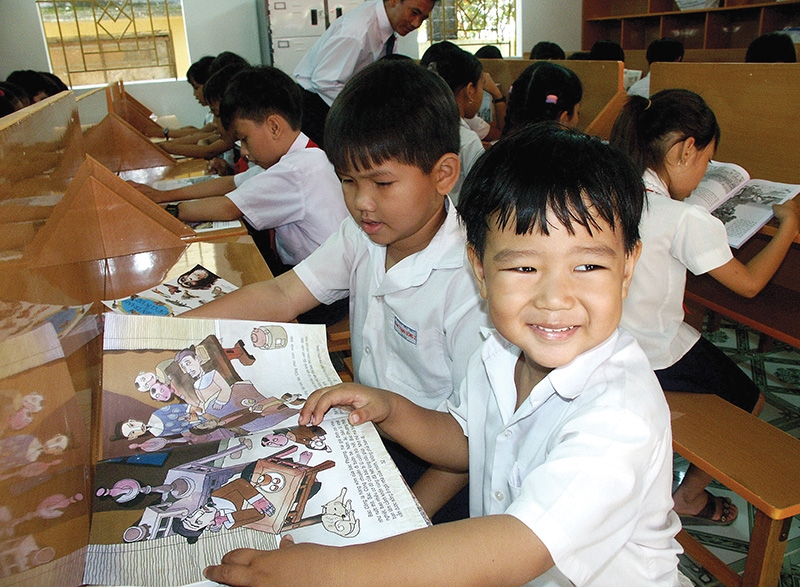Blending welfare into pursuit of prosperity
 |
| The HCI indicates capacities according to health and education standards. Photo: Le Toan |
According to a report by the World Bank Group released a week ago, from 2010 to 2020, the Human Capital Index (HCI) for Vietnam climbed from 0.66 to 0.69.
The HCI is a collaboration between the Human Development Practice Group and the Development Economics Group of the World Bank, and measures which countries are best in mobilising the economic and professional potential of their citizens, thereby indicating how much capital each country loses through lack of education and health. The HCI features data from 174 countries up to March, therefore embracing about 98 per cent of the global population, which provides a pre-pandemic baseline on the health and education of children.
For Vietnam, this would mean a child born in the country today will be nearly two-thirds as productive when they grow up as they could have been if they could access complete education and full health as enjoyed in more affluent nations.
The score is well above the global average of 0.56 and is higher than the average for East Asia and Asia-Pacific, as well as for lower-middle-income nations. An above-average score has enabled Vietnam to reach 38th position among 174 economies in the 2020 HCI.
The index’ components consist of the probability of survival to age five, expected years of education, harmonised test scores (HTS), learning-adjusted years of school, adult survival rate, and healthy growth (not stunted rate). Some 98 out of 100 children born in the country survive to the age of five while a local child who starts school at the age of four can expect to complete 12.9 years of school by the time they are 18.
Accounting for the level of GDP, Vietnam “performed particularly well in learning. The country reaches an HTS of 519, a level similar to countries like Sweden, the Netherlands, and New Zealand, which are significantly richer.”
HTS measures how much children learn in school based on countries’ relative performance on international student achievement tests, where 625 represents advanced attainment and 300 represents minimum attainment.
Furthermore, 87 per cent of 15-year-olds will likely live until the age of 60 in Vietnam.
In Southeast Asia, Vietnam ranked above Brunei (56), Malaysia (62), Thailand (63), Indonesia (96), the Philippines (103), Cambodia (118), Myanmar (120), Laos (126) and Timor-Leste (128).
Vietnam is experiencing rapid demographic and social change. Its population reached 98 million in late 2019 (up from about 60 million in 1986) and is expected to expand to 120 million by 2050. Today, 70 per cent of the population is under 35 years of age, with a life expectancy of 76 years, the highest among countries in the region at similar income levels. But the population is rapidly aging. Vietnam’s emerging middle class, currently accounting for 13 per cent of the population, is expected to reach 26 per cent by 2026.
According to the landmark Vietnam 2035 report, a joint Vietnam-World Bank Group study featuring a path for the country to reach an upper-middle-income status by 2025, human capital development via educational and training quality improvement is flagged as a breakthrough which can help drive the nation to more prosperity.
Vietnam has made tremendous achievements in human development and social inclusion since the launch of doi moi in 1986. It has sustained rapid growth without large increases in inequality that only a few countries have managed at any level of development. Furthermore, it has made impressive gains in healthcare, with sharp gains in life expectancy, steep reductions in infant and maternal mortality, as well as communicable disease incidences, and rapid expansion of health insurance coverage.
The vast majority of children are now in school, and their results on international tests surpass those of many much wealthier nations. The country has also put in place a nascent pension and social safety net system and eased restrictions on the movement of people nationally.
“These accomplishments have contributed to remarkable progress as Vietnam has launched itself out of the ranks of low-income countries,” reads the HCI report.
What the stars mean:
★ Poor ★ ★ Promising ★★★ Good ★★★★ Very good ★★★★★ Exceptional
Related Contents
Latest News
More News
- Protect what’s next: towards a future free from meningococcal group B disease (December 05, 2025 | 18:00)
- New ILO report offers policy recommendations for disability inclusion (December 04, 2025 | 15:18)
- Maternal job loss may affect children’s mental health, research shows (December 03, 2025 | 19:11)
- Women lead Vietnam’s shift to climate-resilient agriculture (December 03, 2025 | 19:10)
- Experts highlight unpaid care work as key barrier to gender equality (December 03, 2025 | 15:15)
- Opportunities and inequalities for women workers in Vietnam's garment industry (December 03, 2025 | 09:00)
- Vietjet flights carry love to devastated central region (November 28, 2025 | 11:35)
- New initiative to boost the fight against domestic violence (November 26, 2025 | 10:00)
- South Korea funds IOM relief for Vietnam’s typhoon-affected communities (November 24, 2025 | 15:33)
- AI and human-centred values set to shape the future of HR in Vietnam (November 21, 2025 | 18:04)

 Tag:
Tag:






















 Mobile Version
Mobile Version